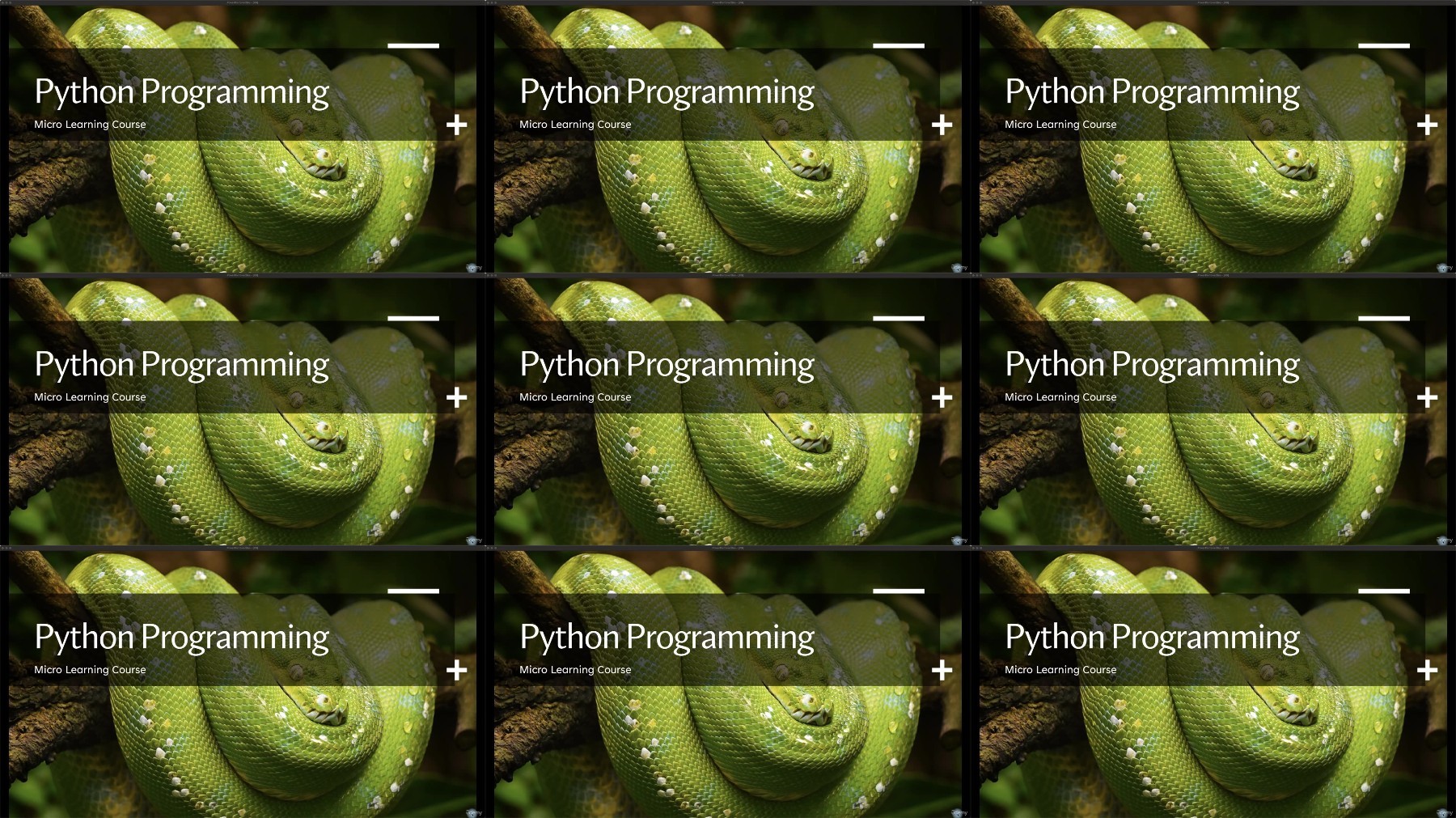Micro Learning | Python Programming

Micro Learning | Python Programming
Published 6/2024
Duration: 3h2m | .MP4 1280x720, 30 fps(r) | AAC, 44100 Hz, 2ch | 631 MB
Genre: eLearning | Language: English
The Python Micro Learning Course
What you'll learn
Understand the basic concepts and syntax of Python Write simple Python programs using variables, data types, and basic operations
Use conditional statements and loops to control the flow of their programs
Define and use functions to organize and reuse code
Read from and write to files using Python
Handle exceptions and errors gracefully
Create and use custom modules and packages
Understand the basics of object-oriented programming (OOP) in Python
Perform basic data processing and visualization using NumPy, Pandas, and matplotlib
Create simple web applications using Flask
Requirements
While no prior programming experience is required, learners should have a basic understanding of computer literacy and be comfortable using a text editor or an integrated development environment (IDE) to write and run Python code.
Description
This Python Microlearning course aims to introduce learners to the basics and advanced features of Python through short, easily digestible lessons. Below is a proposed curriculum covering key areas of Python.
Curriculum
1. Introduction to Python
What is Python and its applications?
Installing and setting up Python
Writing the first Python program: "Hello, World!"
2. Basic Syntax and Data Structures
Variables and data types
Lists, tuples, and dictionaries
Basic operations with lists and dictionaries
3. Conditional Statements and Loops
If-else structures
For and while loops
List comprehensions
4. Functions
Defining and calling functions
Arguments and return values
Lambda functions
5. File Handling
Opening, reading, and writing files
Using context managers
6. Exception Handling
Try-except structures
Defining custom exceptions
7. Object-Oriented Programming (OOP)
Classes and objects
Methods and properties
Inheritance and polymorphism
8. Python Modules and Packages
Creating custom modules
Using built-in modules
Installing and using external packages (pip)
9. Data Processing and Visualization
NumPy and Pandas basics
Simple data visualization with matplotlib
10. Basics of Web Applications
Flask basics
Creating a simple API
Each Lesson Content
Brief
Description
: Introduction to the topic
Practical Example
: Code examples and explanations
Exercises
: Small practical tasks to deepen understanding
Quiz
: Short quiz to check comprehension
Who this course is for:
The course is suitable for beginners with little to no programming experience, as well as those who want to refresh their Python skills or learn new techniques.
More Info

What you'll learn
Understand the basic concepts and syntax of Python Write simple Python programs using variables, data types, and basic operations
Use conditional statements and loops to control the flow of their programs
Define and use functions to organize and reuse code
Read from and write to files using Python
Handle exceptions and errors gracefully
Create and use custom modules and packages
Understand the basics of object-oriented programming (OOP) in Python
Perform basic data processing and visualization using NumPy, Pandas, and matplotlib
Create simple web applications using Flask
Requirements
While no prior programming experience is required, learners should have a basic understanding of computer literacy and be comfortable using a text editor or an integrated development environment (IDE) to write and run Python code.
Description
This Python Microlearning course aims to introduce learners to the basics and advanced features of Python through short, easily digestible lessons. Below is a proposed curriculum covering key areas of Python.
Curriculum
1. Introduction to Python
What is Python and its applications?
Installing and setting up Python
Writing the first Python program: "Hello, World!"
2. Basic Syntax and Data Structures
Variables and data types
Lists, tuples, and dictionaries
Basic operations with lists and dictionaries
3. Conditional Statements and Loops
If-else structures
For and while loops
List comprehensions
4. Functions
Defining and calling functions
Arguments and return values
Lambda functions
5. File Handling
Opening, reading, and writing files
Using context managers
6. Exception Handling
Try-except structures
Defining custom exceptions
7. Object-Oriented Programming (OOP)
Classes and objects
Methods and properties
Inheritance and polymorphism
8. Python Modules and Packages
Creating custom modules
Using built-in modules
Installing and using external packages (pip)
9. Data Processing and Visualization
NumPy and Pandas basics
Simple data visualization with matplotlib
10. Basics of Web Applications
Flask basics
Creating a simple API
Each Lesson Content
Brief
Description
: Introduction to the topic
Practical Example
: Code examples and explanations
Exercises
: Small practical tasks to deepen understanding
Quiz
: Short quiz to check comprehension
Who this course is for:
The course is suitable for beginners with little to no programming experience, as well as those who want to refresh their Python skills or learn new techniques.
More Info

